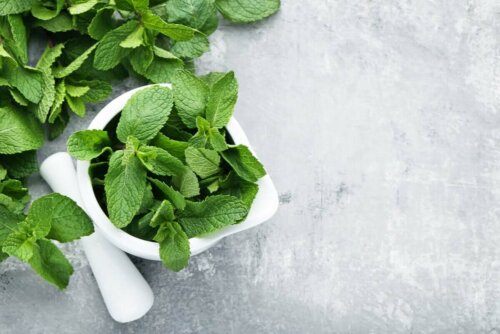Natural Remedies for Migraine in Children

Some natural remedies help ease migraine symptoms in children. According to information published in the Migraine Research Foundation, this condition affects up to 10% of school-age children. In addition, it’s as disabling as the migraine that affects adults.
Its symptoms can include severe headache, nausea, vomiting, dizziness, and sensitivity to light and sound. In fact, it also causes abdominal pain and mood changes. Because of this, the treatment should be guided by your GP or pediatrician.
After doing the relevant tests, the professional will be able to determine the best approach. Regardless, you can try certain natural preparations that provide temporary relief. They’re safe to use in children and help make the condition more bearable. Take note!
Natural remedies for migraine in children
Migraine in children isn’t just a headache. This condition is chronic and causes more severe and disabling symptoms. In specific cases, making natural remedies is useful against the symptoms. Although they shouldn’t be a first-line treatment against this condition, they can prove helpful. What options are there?
1. Peppermint essential oil
The effectiveness of peppermint essential oil against migraines hasn’t yet been proven. However, studies suggest that its use in aromatherapy works against headaches. Also, it seems to have a positive effect on the management of nausea and discomfort.
Research published in Frontiers in Neurology found that a menthol gel (the main active compound in peppermint) can reduce the intensity of acute migraines after two hours. In this case, we propose using it with a base oil.
Ingredients
- 10 drops of peppermint essential oil
- 1 teaspoon of coconut oil (5 grams)
Instructions
- Mix the peppermint essential oil drops with the coconut oil. If you don’t have coconut oil, you can use another oil, such as almond or olive.
- Once you mix the oils, use the product to gently massage your child’s temples, forehead, and back of the neck. Avoid applying it near their eyes, as it can be irritating.
- If you want, you also massage it into their upper abdomen and wrists.
- You can repeat this remedy two to three times a day, until they feel better.

This article may interest you: Speed up Migraine Relief with 6 Natural Solutions
2. Chamomile
You can use both the chamomile plant and its essential oil as natural remedies for migraine in children. Applying and consuming it not only reduces the intensity of headaches but also soothes other symptoms, such as an upset stomach, anxiety, and difficulty sleeping.
Ingredients
- 1 tablespoon of dried chamomile (15 grams)
- 1 cup of water (250 milliliters)
- Peppermint essential oil (optional)
Instructions
- Firstly, add the dried chamomile to a cup of boiling water.
- After 10 minutes, strain the drink and give it to your child.
- Optionally, add about 10 drops of chamomile essential oil to a bowl of boiling water.
- Let the child absorb the vapors so they can enjoy their relaxing effect. You must supervise your child during this remedy to avoid burns.
- If the symptoms persist, repeat it two to three times a day.
3. Magnesium
Migraine can be a clinical manifestation of magnesium deficiency. This essential mineral plays an important role in many bodily functions, including glucose control and nerve transmission.
Scientific evidence determined that magnesium supplementation can aid migraine relief, since it reduces its severity. However, the administration of these products in children should only be suggested by a professional. Otherwise, it’s possible to get it through foods such as:
- Green leafy vegetables
- Beans
- Seeds and nuts
- Whole grains
You don’t want to miss this article: Magnesium Oil: 10 Health Benefits to Know
4. Cold compresses

Applying a cold compress won’t relieve migraines in children. However, it may help provide temporary relief. The application of cold compresses reduces inflammation, slows nerve conduction, and constricts blood vessels. Therefore, it’s suitable for this condition.
Instructions
- Apply a cold compress to your child’s head or neck.
- If you don’t have a cold compress, wrap ice cubes in a towel and apply it in the same way.
- Massage their head or neck for two to three minutes. Then, rest for two more minutes before repeating the process.
- Repeat the remedy twice a day, until your child feels better.
When you should go to the doctor
Without proper treatment, migraines can limit children’s lives. They can even lead to poor school performance. For this reason, it’s best to consult your doctor if your child has any symptoms.
Although natural remedies temporarily help, a professional should prescribe a more effective treatment. Often, this includes dietary and habit adjustments and drugs.
All cited sources were thoroughly reviewed by our team to ensure their quality, reliability, currency, and validity. The bibliography of this article was considered reliable and of academic or scientific accuracy.
- Migraine Research Foundation. (2020). Migraine in kids is not just a bad headache.
Retrieved on July 17, 2020 from https://migraineresearchfoundation.org/about-migraine/migraine-in-kids-and-teens/ - Shah UH, Kalra V. Pediatric migraine. Int J Pediatr. 2009;2009:424192. doi:10.1155/2009/424192
- Kacperski J, Kabbouche MA, O’Brien HL, Weberding JL. The optimal management of headaches in children and adolescents. Ther Adv Neurol Disord. 2016;9(1):53-68. doi:10.1177/1756285615616586
-
Ali, B., Al-Wabel, N. A., Shams, S., Ahamad, A., Khan, S. A., & Anwar, F. (2015). Essential oils used in aromatherapy: A systemic review. Asian Pacific Journal of Tropical Biomedicine, 5(8), 601–611. https://doi.org/10.1016/j.apjtb.2015.05.007
- St Cyr A, Chen A, Bradley KC, Yuan H, Silberstein SD, Young WB. Efficacy and Tolerability of STOPAIN for a Migraine Attack. Front Neurol. 2015;6:11. Published 2015 Feb 4. doi:10.3389/fneur.2015.00011
- Miraj S, Alesaeidi S. A systematic review study of therapeutic effects of Matricaria recuitta chamomile (chamomile). Electron Physician. 2016;8(9):3024-3031. Published 2016 Sep 20. doi:10.19082/3024
-
Dolati S, Rikhtegar R, Mehdizadeh A, Yousefi M. The Role of Magnesium in Pathophysiology and Migraine Treatment. Biol Trace Elem Res. 2020;196(2):375-383. doi:10.1007/s12011-019-01931-z
- Yablon LA, Mauskop A. Magnesium in headache. In: Vink R, Nechifor M, editors. Magnesium in the Central Nervous System [Internet]. Adelaide (AU): University of Adelaide Press; 2011. Available from: https://www.ncbi.nlm.nih.gov/books/NBK507271/
- Köseoglu E, Talaslioglu A, Gönül AS, Kula M. The effects of magnesium prophylaxis in migraine without aura. Magnes Res. 2008;21(2):101-108.
- Sprouse-Blum AS, Gabriel AK, Brown JP, Yee MH. Randomized controlled trial: targeted neck cooling in the treatment of the migraine patient. Hawaii J Med Public Health. 2013;72(7):237-241.
This text is provided for informational purposes only and does not replace consultation with a professional. If in doubt, consult your specialist.








